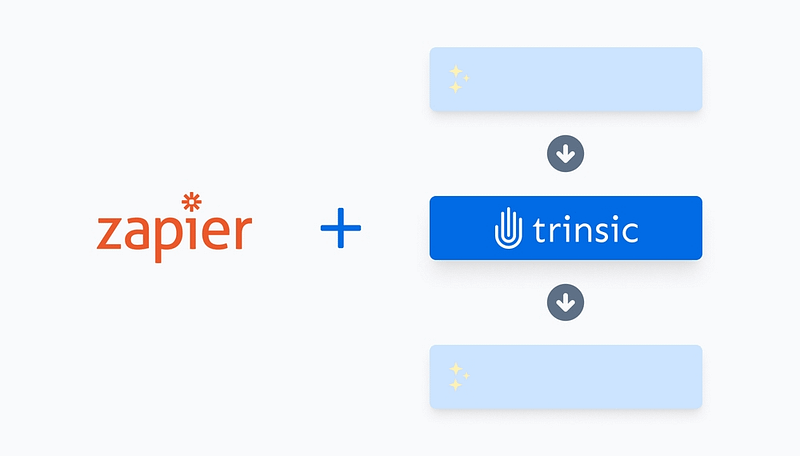G-Suite, Office 365, Slack, Stripe, Asana, Twilio, Trello, Salesforce, LinkedIn, Wordpress, HubSpot, Zoom, Typeform, Discord. What are two things these applications have in common?
- Odds are, you are a user of one or more of them.
- They now work seamlessly with self-sovereign identity (SSI).
In our eternal quest to make SSI easier to adopt, Trinsic partnered with leading workflow automation platform Zapier to enable Trinsic’s developer community to integrate self-sovereign identity with 2000+ common applications without coding! While Trinsic specializes in building the world’s best developer toolkit for decentralized identity, we recognize that plenty of non-technical people want to build SSI integrations. Zapier is the best tool we found to connect the APIs of various different services behind the scenes, making SSI more accessible than ever before.
If you’ve interacted with Trinsic much, you know we issue credentials for all sorts of things. Many of those workflows, including the Stripe, Calendly, and Zoom integrations, were done using Zapier and took less than 15 minutes to set up. We even issued our employees an Employee ID credential using Zapier! But we’re not the only ones who love this feature—see how other innovators are using Trinsic and Zapier to make self-sovereign identity a reality.
Featured use cases
Internet Identity Workshop XXXI
The Internet Identity Workshop (IIW) is arguably the most important digital identity gathering there is. It’s happened every year, twice a year, for over 15 years now. Many of the internet’s most important digital identity standards, including Open ID, OAuth, and most recently SSI, were pioneered at this conference.
When IIW moved virtual, they wanted to practice some of what their community has been working on for several years. Phil Windley, co-founder of the workshop, set up an Eventbrite integration to enable digital tickets for IIW in the form of verifiable credentials.
Sign up for IIW and get a digital, verifiable ticket credential here.
Proof Market
Proof Market is a startup working on MedCreds, a personal health wallet that leverages the Trinsic platform. Through its easy-to-use portal, patients can easily & securely collect their COVID test results, fill out medical questionnaires, and more. MedCreds wanted to keep a pulse on the performance of their application, so they set up a Zapier integration between Trinsic and Slack to notify a channel whenever a new registration is made through the platform.
Sign up for your MedCreds digital health wallet here.

VoteChain
Early-stage startup VoteChain, led by Marine veteran Robert Seitzberg, is building its first prototype using various no-code tools. With SSI technology, he can ensure that a given voter is eligible to vote. He is using Trinsic and Zapier to automate the credential verification process, so he can demo the working prototype to prospective stakeholders.
How it works
The magic happens behind the scenes where the Trinsic API is integrated with the Zapier platform using special webhooks. Zapier specializes in creating workflows, or a series of actions across multiple different apps. Through this process, Zapier can pass data from other apps into Trinsic and visa-versa, enabling completely automated credential exchange workflows.
In Zapier, triggers are an event that initiates an automated workflow and actions are the events that occur in that workflow. In the example below, a new registrant in Eventbrite is the trigger of this workflow. In the workflow, the actions that are completed are issuing a credential, registering for a webinar, and sending a confirmation email to the new event attendee.
With integrations to over 2000 other applications, the sky is the limit in terms of integrations. Build an automated credential exchange workflow in less than 15 minutes by following these instructions:
- First, plan out your use case. Maybe you’re following the lead of the Internet Identity Workshop and issuing verifiable credentials as event tickets. Whatever you’re doing, make a plan for how you want the integration to work.
- Next, head to the Trinsic Studio and create an Organization. You’ll need the API keys for the Organization in order to use Zapier.
- Once in the Trinsic Studio, set up a credential template, verification template, or whatever else you need for your use case.
- Finally, set up the flow in Zapier and follow the prompts you’re given.
Not sure where to start? Try one of the following integrations or check out our documentation:
Build your own integrations
While this is indeed a huge step forward for self-sovereign identity adoption, the real adoption is coming from the hundreds of developers who use the Trinsic platform for the applications they’re building. While we plan to continually improve the Zapier functionality, it will never match the power and flexibility of using the APIs directly.
With Trinsic’s fully-loaded package of 3 APIs, a front-end Studio, robust documentation, and SDKs in popular languages, your team is equipped with the flexibility and functionality needed to build something extraordinary. What integrations will you build?
- Trinsic Studio: An easy-to-use web interface for managing credential exchange with no code. Also serves as the mechanism to acquire API keys and manage billing for paid plans. Try it for yourself completely free, and issue a credential in less than 5 minutes!
- Provider API: Our newest API enables developers to programmatically provision issuer and verifier cloud agents. Learn more about the provider API in the recent launch announcement.
- Credentials API: Our core API enables developers to have a turnkey way to issue, verify, and manage verifiable credentials on any Hyperledger Indy network. Check out our documentation or one of our reference applications to get started.
- Wallet API: An API for creating and managing cloud wallets on behalf of credential holders. It’s the backend of our Mobile SDK, which you can read more about in our recent post about building your own SSI wallets. Get started with the API by checking out the documentation.










